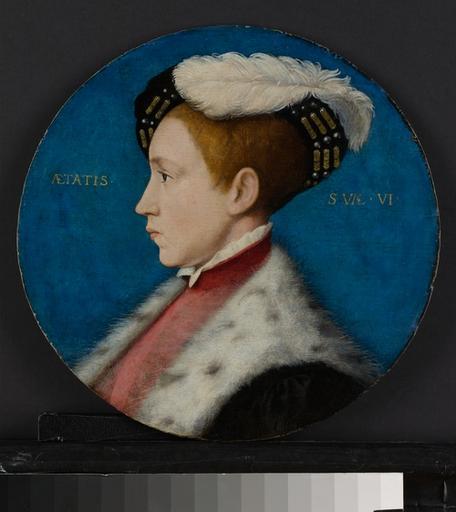MAKE A MEME
View Large Image

| View Original: | Edward_VI,_son_of_Henry_VIII_and_Jane_Seymour,_when_Prince_of_Wales.jpg (500x561) | |||
| Download: | Original | Medium | Small | Thumb |
| Courtesy of: | www.flickr.com | More Like This | ||
| Keywords: jane seymour janeseymour edward vi edwardvi united kingdom unitedkingdom henry viii henryviii six wives of henry viii sixwivesofhenryviii queens of england queensofengland kings of england kingsofengland tudor Edward VI (12 October 1537 – 6 July 1553) became King of England and Ireland on 28 January 1547 and was crowned on 20 February at the age of nine.[1] The son of Henry VIII and Jane Seymour, Edward was the third monarch of the Tudor dynasty and England's first Protestant ruler. During Edward’s reign, the realm was governed by a Regency Council, because he never reached maturity. The Council was led from 1547 to 1549 by his uncle Edward Seymour, 1st Duke of Somerset, and from 1550 to 1553 by John Dudley, 1st Earl of Warwick, who in 1551 became 1st Duke of Northumberland. Edward's reign was marked by economic problems, military withdrawal from Scotland and Boulogne-sur-Mer, and social unrest that in 1549 erupted into riot and rebellion. It also saw the transformation of the Anglican Church into a recognisably Protestant body.[2] Henry VIII had severed the link between the Church of England and Rome, and during Edward's reign, Protestantism was established for the first time in England, with reforms that included the abolition of clerical celibacy and the mass, and the imposition of compulsory services in English. The architect of these reforms was Thomas Cranmer, Archbishop of Canterbury, whose Book of Common Prayer has proved lasting. When Edward fell terminally ill in 1553, he and his Council drew up a "Devise for the Succession" in an attempt to prevent a Catholic backlash against the Protestant Reformation. Edward named his cousin Lady Jane Grey as his heir and excluded his two half sisters, the Catholic Mary and Protestant Elizabeth. On Edward's death at the age of 15, the succession was disputed. Jane survived as queen for only nine days before the Privy Council proclaimed Mary, for whom the people had risen in support in the counties. As queen, Mary proceeded to undo many of Edward's Protestant reforms, but Elizabeth's religious settlement of 1559 was to secure his Protestant legacy. Edward VI (12 October 1537 – 6 July 1553) became King of England and Ireland on 28 January 1547 and was crowned on 20 February at the age of nine.[1] The son of Henry VIII and Jane Seymour, Edward was the third monarch of the Tudor dynasty and England's first Protestant ruler. During Edward’s reign, the realm was governed by a Regency Council, because he never reached maturity. The Council was led from 1547 to 1549 by his uncle Edward Seymour, 1st Duke of Somerset, and from 1550 to 1553 by John Dudley, 1st Earl of Warwick, who in 1551 became 1st Duke of Northumberland. Edward's reign was marked by economic problems, military withdrawal from Scotland and Boulogne-sur-Mer, and social unrest that in 1549 erupted into riot and rebellion. It also saw the transformation of the Anglican Church into a recognisably Protestant body.[2] Henry VIII had severed the link between the Church of England and Rome, and during Edward's reign, Protestantism was established for the first time in England, with reforms that included the abolition of clerical celibacy and the mass, and the imposition of compulsory services in English. The architect of these reforms was Thomas Cranmer, Archbishop of Canterbury, whose Book of Common Prayer has proved lasting. When Edward fell terminally ill in 1553, he and his Council drew up a "Devise for the Succession" in an attempt to prevent a Catholic backlash against the Protestant Reformation. Edward named his cousin Lady Jane Grey as his heir and excluded his two half sisters, the Catholic Mary and Protestant Elizabeth. On Edward's death at the age of 15, the succession was disputed. Jane survived as queen for only nine days before the Privy Council proclaimed Mary, for whom the people had risen in support in the counties. As queen, Mary proceeded to undo many of Edward's Protestant reforms, but Elizabeth's religious settlement of 1559 was to secure his Protestant legacy. | ||||